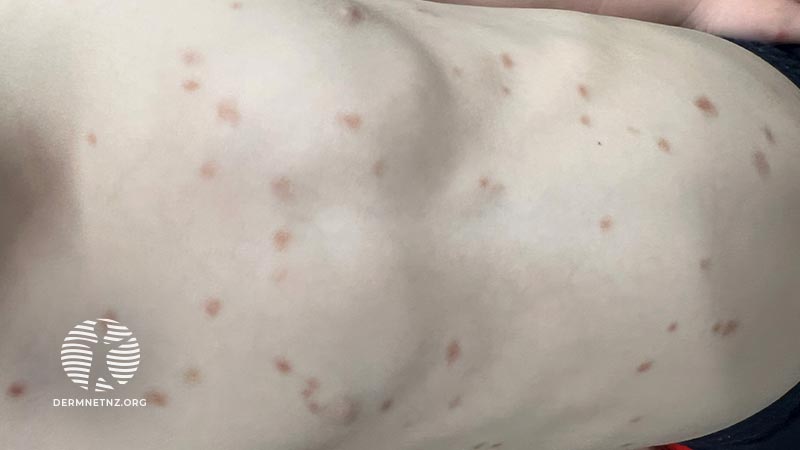Main menu
Common skin conditions

NEWS
Join DermNet PRO
Read more
Quick links
3-year-old with pigmented lesions on trunk
Last reviewed: October 2023
Author: Dr Stanley Leong, Dermatology and Paediatric Registrar, NZ.
Reviewing dermatologist: Dr Ian Coulson (2023).
Edited by the DermNet content department

Background
A 3-year-old boy presented with multiple pigmented skin lesions on his trunk. The initial lesion started on his left knee at 6 months of age. The lesions became more erythematous on hot days or in warm temperature environments, and were otherwise asymptomatic.
On examination, he had multiple yellow-brown flat macules scattered over the trunk and limbs which become more inflamed on scratching.
What is the likely diagnosis?
Urticaria pigmentosa, also known as maculopapular cutaneous mastocytosis, is due to abnormal collection of mast cells in the skin causing brown patches and freckles. It is the commonest type of cutaneous mastocytosis.
It commonly affects infants, with first patches appearing at a few months of age. In young children, it is common for the patches to blister when rubbed.
What is the prognosis?
50 to 70% of cases undergo spontaneous resolution before adolescence.
What is the treatment?
Most children with urticaria pigmentosa do not require any treatment.
Treatment modalities include:
- Oral antihistamines
- Topical steroids
- Topical calcineurin inhibitors
- Phototherapy.
Are there any associated allergies?
Children with urticaria pigmentosa may develop anaphylaxis or anaphylactoid reactions to bee and wasp stings, hence it is advisable for them to carry an injectable adrenaline (epinephrine) kit.
